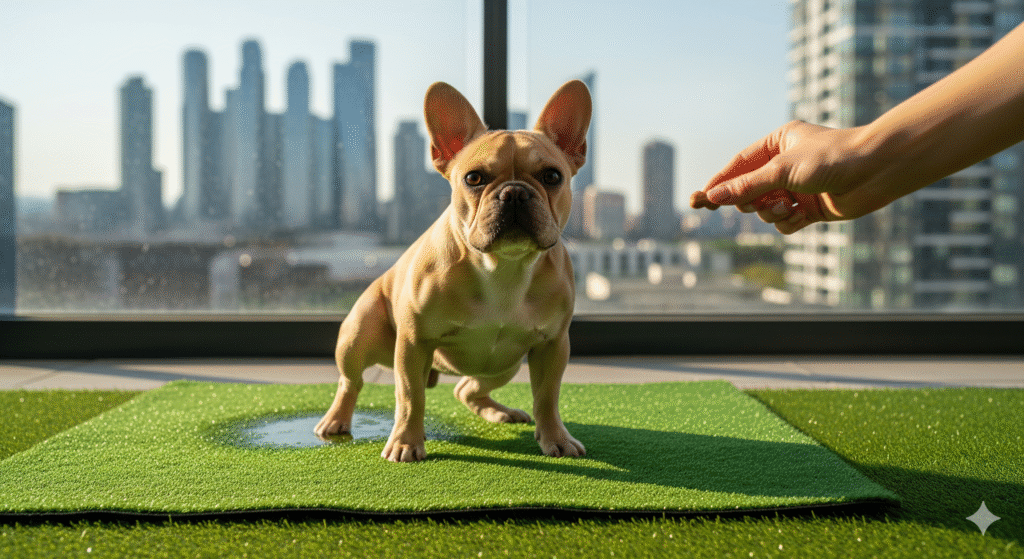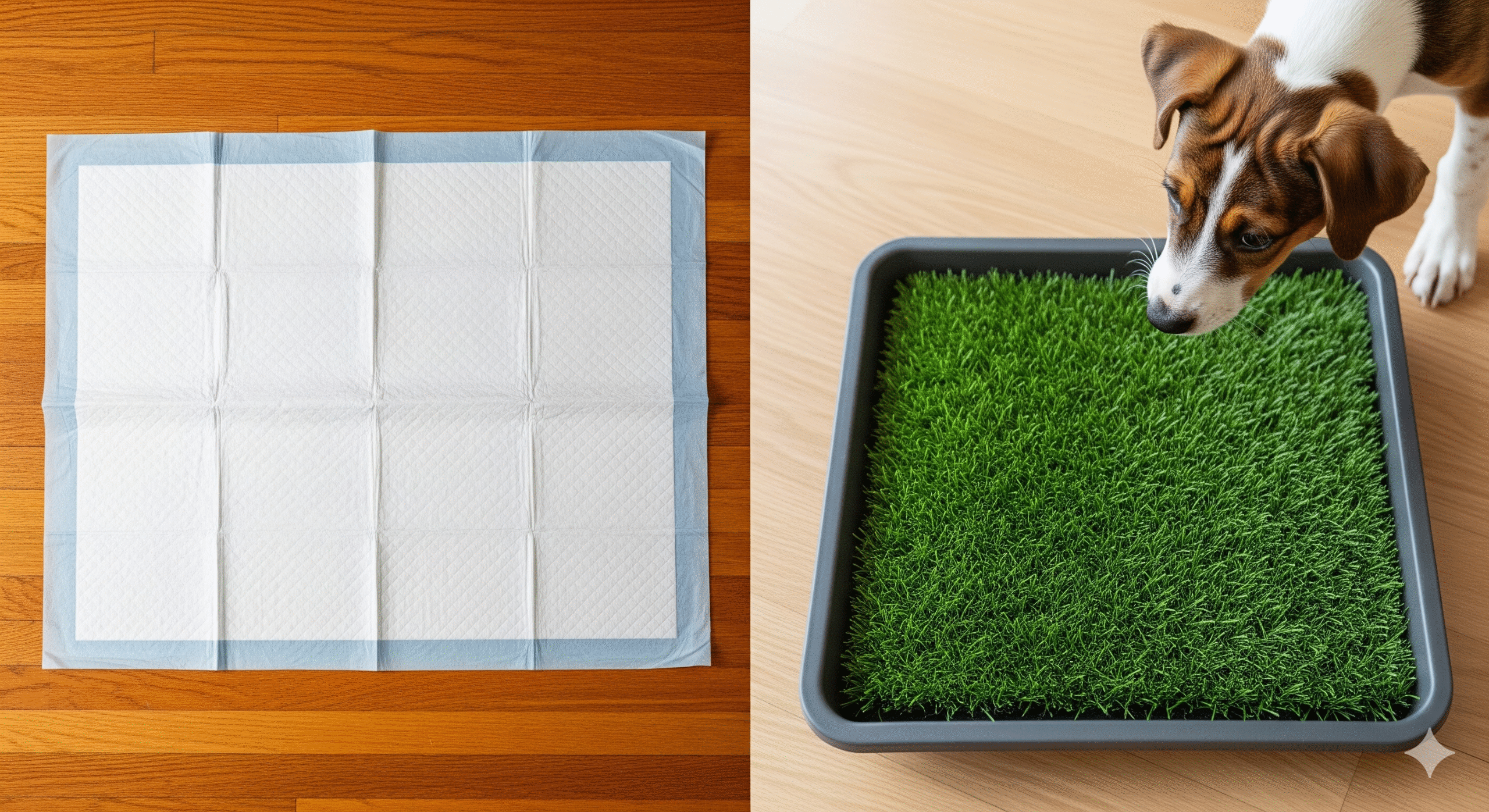Welcome to one of the first and most important decisions you’ll make for your new furry family member: choosing their potty solution. For urban dwellers, apartment residents, or those simply looking for a convenient indoor option, the debate between traditional puppy training pads and modern real or artificial grass pads is a hot topic. 🏙️
Both options aim to solve the same problem—providing a designated spot for your puppy to relieve themselves indoors—but they do it in very different ways. This comprehensive guide will break down the pros, cons, and key differences between puppy training pads vs grass to help you make the most informed decision for your lifestyle, your home, and your pup’s long-term potty training success.
Why Use an Indoor Potty Solution? 🏠
Before we dive into the comparison, let’s understand the why. Indoor potty solutions aren’t a cop-out; they’re a practical tool for many situations.
- Apartment Living: For those on the 15th floor, rushing a puppy downstairs every hour is impractical.
- Young Puppies: Very young pups don’t have full bladder control and need a nearby option, especially overnight.
- Inclement Weather: Blizzards, hurricanes, or pouring rain make outdoor trips unpleasant and can set back training.
- Busy Schedules: For owners who work long hours, it provides a safe, acceptable place for a puppy to go.
- Post-Surgery/Illness: For dogs on strict rest, an indoor option is a necessity.
The Classic Choice: Puppy Training Pads 📦
These are the absorbent, disposable sheets you’re likely familiar with. They are typically made of several layers, including a moisture-proof bottom, a super-absorbent core, and a top sheet that allows liquid to pass through while keeping paws dry.
Advantages of Puppy Training Pads ✅
- High Absorbency & Leak-Proof: Modern pads are highly effective at locking in moisture and odor, preventing accidents on your floors.
- Extremely Convenient: The ultimate in convenience. You simply unroll it, use it, and then throw it away. No cleaning or maintenance required.
- Portable & Disposable: Perfect for travel, placing in a crate, or moving from room to room. Disposal is easy and hygienic.
- Cost-Effective Initially: A small pack of pads is a low upfront cost, making it an easy first step for new owners.
Disadvantages of Puppy Training Pads ❌
- Environmental Impact: 🚯 They create a significant amount of non-biodegradable waste, which is a concern for eco-conscious owners.
- Cost Over Time: While cheap upfront, the cost of continuously buying pads adds up significantly over months.
- Potential for Chewing: Some puppies are tempted to shred and play with the pad, creating a messy and potentially dangerous situation if ingested.
- Can Hinder Outdoor Training: The texture and feel are nothing like grass, which can make the transition to ultimately going outside more confusing for the puppy.
The Modern Alternative: Real or Artificial Grass Pads 🌱
This category includes both patches of real grass delivered via a subscription service and reusable trays of synthetic turf designed for puppy use. They aim to mimic the outdoor experience indoors.
Advantages of Grass Pads ✅
- Easier Transition to Outdoors: This is the biggest benefit. The texture and feel are similar to outside, so your puppy learns to associate the feeling of grass with going potty. This makes eventual outdoor training much smoother.
- Eco-Friendly Option (Reusable): Artificial grass pads are washable and reusable for months or even years, drastically reducing waste.
- More Natural for Dogs: Dogs often naturally gravitate towards grass-like surfaces to eliminate.
- Aesthetically Pleasing: Many look like a small patch of lawn, which is more visually appealing than a disposable pad.
Disadvantages of Grass Pads ❌
- Cleaning & Maintenance: 🧽 This is the biggest drawback. Real grass needs to be replaced every 1-2 weeks. Artificial grass must be rinsed and cleaned frequently to prevent odor and bacteria buildup.
- Higher Upfront Cost: A quality synthetic grass system or a subscription for real grass is more expensive initially than a pack of disposable pads.
- Potential for Mess: If not cleaned immediately or if the tray has a leak, you could be dealing with spilled water or urine on your floor.
- Storage: Real grass subscriptions require space for the delivery box, and the trays themselves need a dedicated spot.
Head-to-Head Comparison: Puppy Training Pads vs. Grass 🥊
| Feature | Puppy Training Pads | Grass Pads (Artificial) |
|---|---|---|
| Upfront Cost | Low ✅ | Higher ❌ |
| Long-Term Cost | High (Ongoing purchase) ❌ | Low (One-time purchase) ✅ |
| Cleanup & Maintenance | Easy (Disposable) ✅ | Requires washing/rinseing ❌ |
| Eco-Friendliness | Poor (Landfill waste) ❌ | Good (Reusable) ✅ |
| Transition to Outdoors | Difficult (Different texture) ❌ | Easy (Same texture) ✅ |
| Odor Control | Good (Absorbent layers) ✅ | Varies (Requires cleaning) ➖ |
| Best For | Temporary use, ultimate convenience, travel | Long-term use, eco-conscious owners, easier outdoor training |
The Verdict: Which One Should You Choose?
The best choice depends entirely on your goals and lifestyle.
- Choose Puppy Training Pads if: You need a temporary, ultra-convenient solution for a very young puppy, for overnight use, or for occasional travel. You prioritize disposable convenience over long-term cost and environmental impact.
- Choose a Grass Pad if: You are committed to an indoor solution for the long haul or want to ensure a seamless transition to outdoor potty training later. You prefer a reusable, eco-friendlier product and don’t mind the extra cleaning step.
Expert Insight: “For clients in apartments who ultimately want their dog to go on grass outside, I almost always recommend starting with an artificial grass pad. It builds the right surface association from day one. The goal is to make the final desired behavior as easy as possible for the dog to understand.” – Michael Evans, Certified Professional Dog Trainer (CPDT-KA)
Pro Tips for Success with Either System 🏆
No matter which option you choose, these tips will maximize your success.
- Location is Key: Place the pad in a quiet, low-traffic, but easily accessible area. Consistency helps your puppy learn where to go.
- Use a Holder/Tray: For training pads, a ventilated tray holder prevents chewing and shifting. For grass pads, ensure the tray is sturdy and leak-proof.
- Positive Reinforcement: 🎉 When your puppy uses the pad correctly, reward them immediately with high-value treats and enthusiastic praise.
- Clean Accidents Thoroughly: Use an enzymatic cleaner anywhere your puppy has an accident outside their designated area. This completely eliminates the odor that draws them back to the same spot.
- Be Patient: House training is a process filled with accidents. Stay consistent and positive.
The Final Step: Transitioning to the Great Outdoors 🌳
If your end goal is for your puppy to go outside exclusively, the transition strategy is crucial.
- With a Grass Pad: This is simple. You can actually move the grass pad gradually closer to the door, then just outside the door, and then eventually remove it entirely once they are comfortable going on the real grass outside.
- With Training Pads: This can be trickier. Start by moving the pad closer to the door. Then, begin offering more frequent trips outside, rewarding heavily for success. You may need to temporarily place a pad outside on a balcony or patio as an intermediate step.
The Bottom Line: There’s No One-Size-Fits-All Answer 🤷♀️
Both puppy training pads and grass pads are valuable tools in a pet owner’s arsenal. By weighing the factors of cost, convenience, environmental impact, and your long-term training goals, you can confidently choose the system that will set your puppy up for success and make your life easier.
Which solution are you leaning towards for your pup? Share your thoughts or ask questions in the comments below—let’s help each other navigate puppy parenthood! 👇

“Before you begin your first training session, it’s helpful to have a few key items ready. You’ll need a supply of small, high-value treats that your puppy loves, a non-distracting environment, and a lot of patience. Another invaluable tool for modern positive reinforcement training is a clicker. This simple device isn’t mandatory, but it significantly improves communication and speeds up the learning process by providing pinpoint accuracy. If you’re ready to add this tool to your training toolkit, our guide to the Best Clickers for Puppy Training will help you choose the right one for your needs.”






